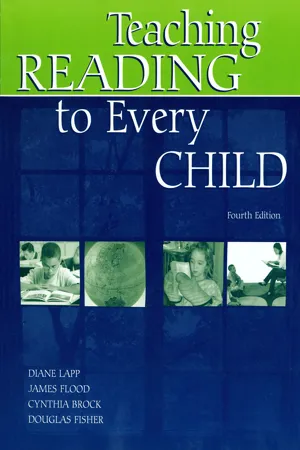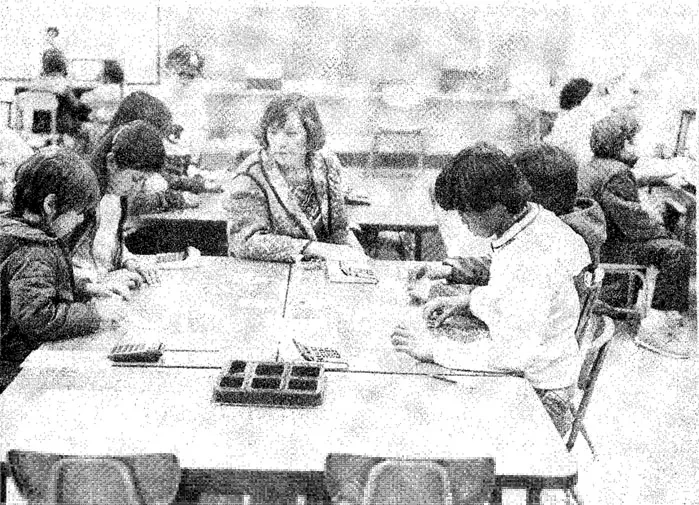
- 472 pages
- English
- ePUB (mobile friendly)
- Available on iOS & Android
Teaching Reading to Every Child
About This Book
This popular text, now in its Fourth Edition, introduces pre-service and in-service teachers to the most current theories and methods for teaching literacy to children in elementary schools. The methods presented are based on scientific findings that have been tested in many classrooms. A wealth of examples, hands-on activities, and classroom vignettes--including lesson plans, assessments, lists of children's literature books to fiction and nonfiction texts, and more--illustrate the methods and bring them to life.The text highlights the importance of teaching EVERY child to become competent in all of the nuances and complexities of reading, writing, and speaking.The value of reflection and peer discussion in learning to expand their students' literacies is emphasized. Readers are encouraged to reflect on their own experiences with reading and teaching throughout their lifetimes--experiences that will serve well in learning to teach reading. "Your Turn" boxes invite readers to think about their views of the material presented, and to talk with colleagues and teachers about their "best ways" of learning this new information. "Did You Notice?" boxes engage readers in observation and analysis of methods and classroom situations discussed in the text. Teachers' stories serve as models of successful teaching and to draw readers into professional dialogue about the ideas and questions raised. End-of-chapter questions and activities provide additional opportunities for reflection and discussion. All of these pedagogical features help readers expand and refine their knowledge in the most positive ways.Topics covered in Teaching Reading to Every Child, Fourth Edition:
*Getting to Know Your Students as Literacy Learners;
*Looking Inside Classrooms: Organizing Instruction;
*Assessing Reading Achievement;
*The Importance of Oral Language in Developing Literacy;
*Word Identification Strategies: Pathways to Comprehension;
*Vocabulary Development;
*Comprehension Instruction: Strategies At Work;
*Content Area Learning;
*What the Teacher Needs to Know to Enable Students' Text Comprehension;
*Writing: Teaching Students to Encode and Compose;
*Discovering the World Through Literature;
*Technology and Media in Reading;
*Teaching Reading to Students Who Are Learning English;
*All Students are Special: Some Need Supplemental Supports and Services to Be Successful; and
*Historical Perspectives on Reading and Reading Instruction. New in the Fourth Edition:
*A new chapter on technology with state-of-the-art applications;
*A new chapter with the most up-to-date information on how vocabulary is learned and on how it is best taught, responding to the national renewed interest in vocabulary instruction;
*A new section on Readers/Writer's workshop with a focus on supporting student inquiry and exploration of multiple genres;
*A more comprehensive chapter on literature instruction and the role of literature in the reading program with examples that support students' multigenre responses;
*A discussion of literary theories with examples for classroom implementation;
*Broader coverage of the phases of reading development from the pre-alphabetic stage to the full alphabetic stage;
*A more inclusive chapter on writing instruction; and
*A thoroughly revised chapter on teaching reading to students who are learning English, including extensive information on assessment and evaluation.
Frequently asked questions
Information
Part One The Wonderful World of Literacy: Getting to Know Your Students, Classrooms, and Your Instructional Style
Chapter 1 Getting to Know Your Students as Literacy Learners
Chapter Goals
- explore ways to get to know students as individuals.
- explore ways to get to know students as learners.
- explore ways to get to know students as literacy learners.

“… What could be clearer; what could be more simple? How could we have lost sight so easily of the solution to our school problems? What our educators need is a camaraderie. A commitment to public education, an independence from bureaucracy an involvement of parents and a belief in students. But … to think that's all that's needed would be a serious miscalculation. What else is needed is something the teachers themselves are reluctant to talk about openly. And it is our respect for them. It is what's missing in America, and it is what's been too long withheld from a profession as important to our national well-being as doctors or captains of industry or TV commentators. From sunup to sundown, the school teacher works harder than you do—no matter what you do. No calling in our society is more demanding than teaching; no calling in our society is more central to the vitality of a democracy than teaching.”Roger Mudd on Learning in America, PBS
Overview Of chapter 1 Objectives


Teachers' Stories: Gaining Insights About Students
Ashley: Wondering About Grouping for Literacy instruction
Table of contents
- Cover Page
- Halftitle Page
- Title Page
- Copyright Page
- Brief Table of Contents
- Table of Contents
- Preface
- PART I The Wonderful World of Literacy: Getting to Know Your Students, Classrooms, and Your Instructional Style
- PART II Developing Literacy Performance and Preferences
- Author Index
- Subject Index